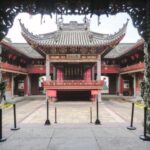Qin’s Ancestral Hall is located in the western section of May Street, Haishu District, Ningbo City, showcasing exquisite craftsmanship and ingenuity. The hall is aligned along a north-south axis, comprising a screen wall, entrance hall, stage, main hall, rear hall, and side rooms, forming a grand timber structure complex. The rectangular layout spans an area of 2165 square meters.
The stage, the most splendid part of the entire construction, covers an area of 30.25 square meters, with a width of 6.1 meters and a depth of 5.9 meters. The ceiling design is ingenious, featuring 16 geometric curves composed of dougong brackets and flower boards that spiral upwards to converge at the dome top, with a mirror in the center, offering a view akin to stepping into a wondrous realm. It is now listed as a national key cultural relics protection unit.

Qin’s Ancestral Hall epitomizes the essence of folk architecture. Its layout, design, and decoration adhere to the traditional Jiangnan construction style, integrating wood carving, brick carving, stone carving, gilding, and other folk crafts, presenting a unique Ningbo regional style. The carvings feature 140 intricate and gorgeous patterns, including scenes of children at play, fishing, woodcutting, farming, and reading, as well as stories of figures from the ‘Romance of the Three Kingdoms’ and ‘Biography of Yue Fei’, and auspicious designs such as dragons and phoenixes, and magpies on plum blossoms.
These patterns add a touch of sublimation to the architecture, with profound connotations and rich implications, embodying human emotions and wishes, and endowing it with enduring artistic vitality.
The distinctive Vermilion-Gold Wood Carving, a traditional craft with a long history in Ningbo, is exemplified in the carvings of Qin’s Ancestral Hall. Techniques such as relief and through-carving are extensively used on beams, brackets, lintels, and balustrades, enhanced by line carving and protruding blocks, coated with lacquer, and adorned with gold leaf, achieving a resplendent golden effect.

The brick carvings of Qin’s Ancestral Hall are also distinctive, with various brick carvings depicting figures and auspicious patterns embedded in screen walls, flower walls, and lattice windows, characterized by vivid shapes and delicate, smooth carving techniques, adding unique charm.
Qin’s Ancestral Hall represents an outstanding example of modern southern ancestral halls. Built by a wealthy Ningbo merchant in modern times, it is grand in scale, exquisite in craftsmanship, and well-preserved, holding a representative position among the family ancestral halls preserved in the south. It reflects the Ningbo commercial culture. Ningbo, a commercial and industrial city, has seen its merchants make significant contributions and hold a unique position in the development of Chinese commerce.
Qin Jun’an, a representative figure of the Qin clan and the progenitor of Qin’s Ancestral Hall, is one such example. Influenced by traditional Confucian thoughts and values while engaging in commerce, these merchants often returned to their hometowns after success, investing their fortunes in constructing ancestral halls, temples, academies, schools, bridges, and roads, reflecting their customs and ethos where Confucianism and commerce coexist without conflict.The specific business hours and operational status of the entire text are subject to the actual opening conditions on the day.









